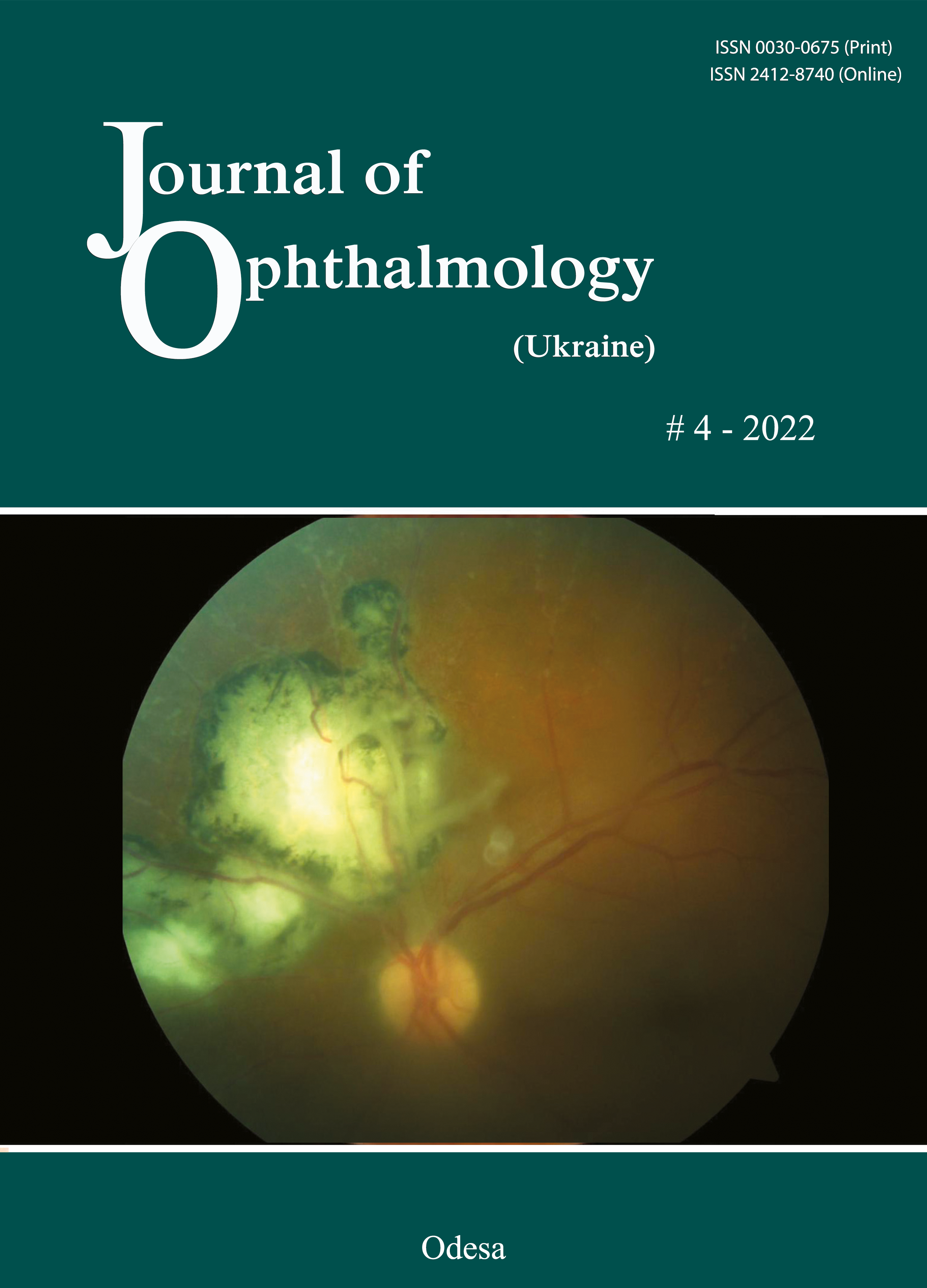Effects of carnosine on the pro-antioxidative status of the anterior segment of the eye in experimental uveitis plus ocular hypertension
DOI:
https://doi.org/10.31288/oftalmolzh202243339Keywords:
non-infectious uveitis, ocular hypertension, antioxidative enzymes, peroxidation, carnosineAbstract
Background: Finding means for improving the effectiveness of drug therapy of ocular inflammatory disorders, especially those with comorbidities, is a challenge to ophthalmology.
Purpose: To assess the efficacy of carnosine for improving the pro/antioxidative imbalance in the anterior segment of rabbit eyes with experimental anterior uveitis in the presence of ocular hypertension (OHT).
Material and Methods: Thirty-three rabbits were used in the study. Group 1 (the control group) comprised 9 intact rabbits and group 2, 12 animals with OHT induced prior to experimental non-infectious uveitis. Group 3 comprised 12 animals in which carnosine 5% was administered bilaterally into the conjunctival sac twice daily for four weeks for OHT induced prior to experimental non-infectious uveitis. Non-infectious uveitis was induced by injecting albumin into the anterior chamber, and OHT was induced by a single 0.1-mL injection of carbomer 0.3% into the anterior chamber. Activities of superoxide dismutase, catalase, glutathione peroxidase, NADH-oxidase and xanthine oxidase, and levels of total proteins and malondialdehyde (MDA) and diene conjugate (DC) in uveal tissue (iris and ciliary body) and aqueous humor specimens were determined.
Results: Uveal activities of NADH-oxidase and xanthine oxidase were 19.4% (р < 0.05) and 27.2% (р < 0.01), respectively, lower in eyes of rabbits treated with carnosine than in eyes of animals not treated for anterior uveitis plus OHT. Uveal activities of glutathione peroxidase, superoxide dismutase and catalase were 34.7%, 39.6% and 28.4%, respectively, higher, and uveal MDA and DC levels were 39.3% and 33.3%, respectively, lower, in eyes of the former rabbits than of the latter rabbits. Similar changes were found in aqueous humor specimens of the experimental rabbits.
Conclusion: Carnosine, when instilled locally, contributed to improvement in the pro/antioxidative imbalance in the anterior segment of rabbit eyes with uveitis plus OHT. It is reasonable to include carnosine-based eye drops into multiagent therapy of uveitis complicated by OHT due to their antioxidative, anti-inflammatory and membrane-stabilizing effects.
References
1.Zborovskaya AV, Dorokhova A.V. [Use of biological therapy in the treatment of uveitides: Current trends]. Oftalmol Zh. 2017;5:60-5. Russian.
2.Krakhmaleva DA, Pivin EA, Trufanov SV, Malozhen SA. [Modern opportunities in uveitis treatment]. Ophthalmology in Russia. 2017;14(2):113-119. Russian. https://doi.org/10.18008/1816-5095-2017-2-113-119
3.Relhan N, Yeh S, Albini TA. Intraocular sustained-release steroids for uveitis. Int Ophthalmol Clin. 2015; 55(3): 25-38. https://doi.org/10.1097/IIO.0000000000000075
4.Jabs DA. Immunosuppression for the Uveitides. Ophthalmology. 2018;125:193-202. https://doi.org/10.1016/j.ophtha.2017.08.007
5.Friedman DS, Holbrook JT, Ansari H, et al. Risk of elevated intraocular pressure and glau coma in patients with uveitis: results of the multicenter uveitis steroid treatment trial. Ophthalmology. 2013 Aug;120(8):1571-9. https://doi.org/10.1016/j.ophtha.2013.01.025
6.Gallego-Pinazo R, Dolz-Marco R, Martínez-Castillo S, et al. Update on the principles and novel local and systemic therapies for the treatment of non-infectious uveitis. Inflamm Allergy Drug Targets. 2013 Feb;12(1):38-45. https://doi.org/10.2174/1871528111312010006
7.Panchenko NV, Khramova TA, Litvishchenko AI, et al. [Changes in the basal vitreous in uveitis treated by adalimumab]. Oftalmol Zh. 2015;6:64-7. Russian.
8.Lerman MA, Rabinovich CE. The Future Is Now: Biologics for Non-Infectious Pediatric Anterior Uveitis. Paediatr Drugs. 2015 Aug;17(4):283-301. https://doi.org/10.1007/s40272-015-0128-2
9.Yadav UC, Kalariya NM, Ramana KV. Emerging role of antioxidants in the protection of uveitis complications. Curr Med Chem. 2011;18(6):931-42. https://doi.org/10.2174/092986711794927694
10.Njie-Mbye YF, Kulkarni-Chitnis M, Opere CA, et al. Lipid peroxidation: pathophysiological and pharmacological implications in the eye. Front Physiol. 2013 Dec 16;4:366. https://doi.org/10.3389/fphys.2013.00366
11.Yadav UCS. Oxidative Stress-Induced Lipid Peroxidation: Role in Inflammation. In: Rani V, Yadav UCS, eds. Free Radicals in Human Health and Disease. New Delhi: Springer India; 2015. pp.119-29. https://doi.org/10.1007/978-81-322-2035-0_9
12.Nita M, Grzybowski A.The Role of the Reactive Oxygen Species and Oxidative Stress in the Pathomechanism of the Age-Related Ocular Diseases and Other Pathologies of the Anterior and Posterior Eye Segments in Adults. Oxid Medicine Cell Longev. 2016;2016:3164734. https://doi.org/10.1155/2016/3164734
13.Mikheytseva IM, Bondarenko NV, Kolomiichuk SG, Siroshtanenko TI. Oxidation and peroxidation in the uvea of the rabbit eyes with experimental uveitis and ocular hypertension. J Ophthalmol (Ukraine). 2019;2:55-60. https://doi.org/10.31288/oftalmolzh201925560
14.Mikheytseva IM, Bondarenko NV, Kolomiichuk SG, et al. The effect of high intraocular pressure on enzymatic antioxidant system of uveal tissues in rabbits with experimental allergic uveitis. J Ophthalmol (Ukraine). 2019;4:57-63. https://doi.org/10.31288/oftalmolzh201945763
15.Hsu S-M, Yang C-H, Teng Y-T, et al. Suppression of the Reactive Oxygen Response Alleviates Experimental Autoimmune Uveitis in Mice. Int J Mol Sci. 2020 May 5;21(9):3261. https://doi.org/10.3390/ijms21093261
16.Vitovska OP, Pichkur LD. Prospects of up-to-date antioxidants in the treatment of chronic eye diseases. J Ophthalmol (Ukraine). 2020;3:42-6. https://doi.org/10.31288/oftalmolzh202034246
17.Göncü T, Oğuz E, Sezen H, et al. Anti-inflammatory effect of lycopene on endotoxin-induced uveitis in rats. Arq Bras Oftalmol. Nov-Dec 2016;79(6):357-62. https://doi.org/10.5935/0004-2749.20160102
18.Choi Y, Jung K, Kim HJ, et al. Attenuation of Experimental Autoimmune Uveitis in Lewis Rats by Betaine. Exp Neurobiol. 2021 Aug 31;30(4):308-317. https://doi.org/10.5607/en21011
19.Chen S-J, Lin T-B, Peng H-Y, et al. Protective Effects of Fucoxanthin Dampen Pathogen-Associated Molecular Pattern (PAMP) Lipopolysaccharide-Induced Inflammatory Action and Elevated Intraocular Pressure by Activating Nrf2 Signaling and Generating Reactive Oxygen Species. Antioxidants (Basel). 2021 Jul 7;10(7):1092. https://doi.org/10.3390/antiox10071092
20.Mikheitseva IM, Bondarenko NV, Kolomiichuk SG, Siroshtanenko TI. Clinical picture of uveitis in the presence of ocular hypertension and improvement in disease course with dipeptide carnosine. J Ophthalmol (Ukraine). 2021;1:55-61. https://doi.org/10.31288/oftalmolzh202115561
21.Prokopieva VD, Yarygina EG, Bokhan NA, Ivanova SA. Use of Carnosine for Oxidative Stress Reduction in Different Pathologies. Oxid Med Cell Longev. 2016;2016:2939087. https://doi.org/10.1155/2016/2939087
22.Menon K, Mousa А, de Courten В. Effects of supplementation with carnosine and other histidine-containing dipeptides on chronic disease risk factors and outcomes: protocol for a systematic review of randomised controlled trials. BMJ Open. 2018 Mar 22;8(3):e020623. /doi.org/10.1136/bmjopen-2017-020623
23.Information Bulletin No. 19 issued 10.10.2019, based on Pat. of Ukraine №137,107; MPK (2019.01) А61К 9/00. [Method for inducing non-infectious uveitis in the presence of ocular hypertension]. Authors: Mikheytseva IM, Kolomiichuk SG, Bondarenko NV, Siroshtanenko TI. Owner: State Institution Filatov Institute of Eye Diseases and Tissue Therapy, NAMS of Ukraine. Ukrainian.
24.Xu Y, Chen Z, Song J. A study of experimental carbomer glaucoma and other experimental glaucoma in rabbits. Zhonghua Yan Ke Za Zhi. 2002 Mar;38(3):172-5.
25.Makarenko EV. [Complex determination of the activity of superoxide dismutase and glutathione reductase in erythrocytes of patients with chronic liver disease]. Lab Delo. 1988;11:48-50. Russian.
26.Koroliuk MA, Ivanova LI, Maĭorova IG, Tokarev VE. [A method of determining catalase activity]. Lab Delo. 1988;(1):16-8. Russian.
27.Model MA. [On the determination of the activity of glutathione peroxidase]. Voporosy meditsinskoi khimii. 1989;4:132-3.
28.Fried R, Fried L. Xanthin-Oxydase (Xanthin-Dehydrogenase). In: HU Bergmeyer. [Methods of enzymatic analysis]. Berlin: Аcademie Verlag, 1984. p. 625-9. German.
29.Larson E, Howlet В, Jagendorf А. Artificial reductant enhancement of the Lowry method for protein determination. Anal Biochem. 1986 Jun;155(2):243-8. https://doi.org/10.1016/0003-2697(86)90432-X
30.Orekhovich VN. [Current methods in biochemistry]. Moscow: Meditsina; 1977. Russian.
31.Rybalchenko VK. [Membrane structure and function]. Kyiv: Vyshcha shkola; 1988. Russian.
32.Babizhayev MA. Generation of reactive oxygen species in the anterior eye segment. synergistic codrugs of N-acetylcarnosine lubricant eye drops and mitochondria-targeted antioxidant act as a powerful therapeutic platform for the treatment of cataracts and primary open-angle glaucoma. BBA Clin. 2016 Apr 19;6:49-68. https://doi.org/10.1016/j.bbacli.2016.04.004
33.Boldyrev AA, Stvolinsky SL, Fedorova TN, Suslina ZA. Carnosine as a natural antioxidant and geroprotector: from molecular mechanisms to clinical trials. Rejuvenation Res. 2010 Apr-Jun;13(2-3):156-8. https://doi.org/10.1089/rej.2009.0923
34.Boldyrev AA, Aldini G, Derave W. Physiology and Pathophysiology of Carnosine. Physiol Rev. 2013 Oct;93(4):1803-45. https://doi.org/10.1152/physrev.00039.2012
35.Cararo JH, Streck EL, Schuck PF, Ferreira G da C. Carnosine and Related Peptides: Therapeutic Potential in Age-Related Disorders. Aging Dis. 2015 Oct 1;6(5):369-79. https://doi.org/10.14336/AD.2015.0616
36.Babizhayev MA. Biological activities of the natural imidazole-containing peptidomimetics N-acetylcarnosine, carcinine and L-carnosine in ophthalmic and skin care products. Life Sci. 2006 Apr 11;78(20):2343-57. https://doi.org/10.1016/j.lfs.2005.09.054
37.Baran EJ. Metal complexes of carnosine. Biochemistry (Mosc). 2000 Jul;65(7):789-97.
38.Vistoli G, de Maddis D, Straniero V, et al. Exploring the space of histidine containing dipeptides in search of novel efficient RCS sequestering agents. Eur J Med Chem. 2013 Aug;66:153-60. https://doi.org/10.1016/j.ejmech.2013.05.009
39.Hipkiss AR. Aging, Proteotoxicity, Mitochondria, Glycation, NAD and Carnosine: Possible Inter-Relationships and Resolution of the Oxygen Paradox. Front Aging Neurosci. 2010 Mar 18;2:10. https://doi.org/10.3389/fnagi.2010.00010
40.Hipkiss AR. Carnosine and protein carbonyl groups: a possible relationship. Biochemistry (Mosc). 2000 Jul;65(7):771-8.
41.Pepper ED, Farrell MJ, Nord G, Finkel SE. Antiglycation effects of carnosine and other compounds on the long-term survival of Escherichia coli. Appl Environ Microbiol. 2010 Dec;76(24):7925-30. https://doi.org/10.1128/AEM.01369-10
42.Aydín AF, Küskü-Kiraz Z, Doğru-Abbasoğlu S, Uysal M. Effect of carnosine treatment on oxidative stress in serum, apoB-containing lipoproteins fraction and erythrocytes of aged rats. Pharmacol Rep. 2010 Jul-Aug;62(4):733-9. https://doi.org/10.1016/S1734-1140(10)70331-5
43.Tsai SJ, Kuo WW, Liu WH, Yin MC. Antioxidative and anti-inflammatory protection from carnosine in the striatum of MPTP-treated mice. J Agric Food Chem. 2010 Nov 10;58(21):11510-6. https://doi.org/10.1021/jf103258p
44.Mikheytseva IM, Bondarenko NV, Kolomiichuk SG, Kuryltsiv NB. Neopterin level in the anterior segment of the eye in induced uveitis with ocular hypertension treated by dipeptide carnosine. J Ophthalmol (Ukraine). 2021;2:64-70. https://doi.org/10.31288/oftalmolzh202156470
Downloads
Published
How to Cite
Issue
Section
License
Copyright (c) 2025 І. М. Михейцева, Н. В. Бондаренко, C. Г. Коломійчук

This work is licensed under a Creative Commons Attribution 4.0 International License.
This work is licensed under a Creative Commons Attribution 4.0 International (CC BY 4.0) that allows users to read, download, copy, distribute, print, search, or link to the full texts of the articles, or use them for any other lawful purpose, without asking prior permission from the publisher or the author as long as they cite the source.
COPYRIGHT NOTICE
Authors who publish in this journal agree to the following terms:
- Authors hold copyright immediately after publication of their works and retain publishing rights without any restrictions.
- The copyright commencement date complies the publication date of the issue, where the article is included in.
DEPOSIT POLICY
- Authors are permitted and encouraged to post their work online (e.g., in institutional repositories or on their website) during the editorial process, as it can lead to productive exchanges, as well as earlier and greater citation of published work.
- Authors are able to enter into separate, additional contractual arrangements for the non-exclusive distribution of the journal's published version of the work with an acknowledgement of its initial publication in this journal.
- Post-print (post-refereeing manuscript version) and publisher's PDF-version self-archiving is allowed.
- Archiving the pre-print (pre-refereeing manuscript version) not allowed.












